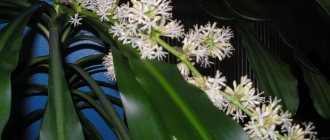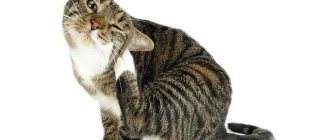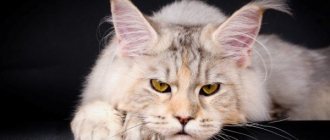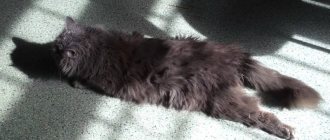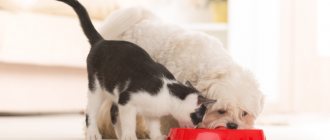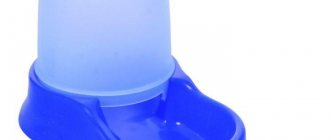The love for furry four-legged pets often coexists with a passion for all kinds of homemade greens. Just remember that not every plant is suitable for animals. Even if the flower itself is recommended by experts as safe, the pests that have settled on it or the spraying and feeding agents used can cause serious allergies or other diseases.
We offer a list of plants that will not harm your animals and at the same time look great in the interior or in the local area.
Palms (Arecaceae)
There are several species in the palm family that are completely safe for dogs or cats in contact with them: Chamaedorea elegans, Beaucarnea. But the Japanese cycad (Cycas revoluta) is very toxic. When interacting with animals, he seems to be a rather aggressive irritant.
What else should you pay attention to when you have home flowers and a cat?
Although these species do not usually pose a threat to cats, it may happen that the animal will be allergic to them, so if you notice alarming symptoms in your pet after contact with the plant, it is best for us to remove it from the apartment.
We can also discourage cats from biting our flowers by placing a prickly cactus near them with larger, less sharp thorns (small animals can cause damage).
ATTENTION: The article does not mention all house flowers that can harm a cat, but the most popular types. When we buy a new plant, it is better to check whether the species is dangerous for cats.
Remember that a cat can be allergic to even a theoretically safe plant, so let's take a look at our "cat". Rice. StockSnap - pixabay.com
Bamboo
Of all the bamboos, preference should be given only to the decorative variety Phyllostachys aurea. Other species can also be raised in homes where dogs live. But you should be careful with cats. For them, dracerna (Dracaena sanderiana), popular among flower growers, or the sacred Nandina bamboo are quite toxic.
Plants are safe for cats and dogs. Thimble cactus (Mammillaria gracilis fragilis)
These attractive succulents are native to Central America. There they usually get plenty of bright sun and some water.
This means they are easy to care for and just need a bright spot in your home. Mammillaria will grow well on windows, producing light yellow flowers in winter and summer.
Tips for caring for plants
- Light:
Requires bright sunlight at least 6 hours a day. - Watering:
The cactus rarely needs water. Do not overfill. - Soil:
Pot drainage, soil with stones or pumice.
Violets (Streptocarpus ionanthus)
The Latin name Streptocarpus hides the familiar violets. They are absolutely safe for four-legged animals and therefore very common. Since there are more than a thousand varieties of hybrids of this flower, those who like to combine animals and greenery have a very large choice.
What are the people saying?
Many people advise protecting flowers by placing citrus peels, onion slices, or cotton balls soaked in vinegar in a flowerpot. Cats don't like their smell, it repels animals and can give the plant a chance to live. Only in this case you should not completely calm down. Animals are like people: different characters and tastes. Your pet may enjoy a slice of lemon as an aperitif.
The only plant that a cat will not eat under any circumstances is wild rue. But you should not use it to protect indoor flowers - its smell alone can cause an allergic reaction in your pet.
So, now it’s clear which flowers cats don’t eat. They do not eat plants that are in another room or in a flower bed outside the window. And only because he is unable to reach them. If you really love cats and plants, and are unable to give up one of your attachments, choose the most phlegmatic and independent breed.
Phlegmatic people will weigh the pros and cons a hundred times, and, most likely, will prefer lying on a soft sofa to a dangerous journey through radiators and curtains to the coveted window sill. Well, independent cats will always find something more interesting to do, because they are self-sufficient and calmly tolerate the absence of their owners. Only if these cats also look up with suspicious curiosity at luxurious geraniums or just blooming hibiscus, is it worth spending money and purchasing a “Cat Garden”, where the grass will grow over time.
Chlorophytum comosum
Chlorophytum is often also called a spider or airplane plant due to the fact that housewives try to hang it somewhere higher. The drooping stems of the herbaceous bush hang spectacularly, do not require special care and do not need frequent watering. And for cats and dogs they do not pose the slightest danger, rightfully occupying a high place in our rating.
List of Stylish Houseplants That Are Pet-Friendly
Today we will discuss which plants in the interior of an apartment will be completely safe for the health of pets. We are sure that many of our subscribers ask this question only after they got a cat or dog.
This post is intended as a must-read for all animal lovers. The list presented below contains only those indoor greens that, by all indications, are safe.
The list contains six beautiful and completely safe indoor flowerpots that can decorate your apartment, making it stylish, and will not cause any harm to our smaller brothers.
Spider plants
Let's start with vegetation that does not bloom, but can decorate any home with its lush greenery. Spider plants are one of them. The sharp, sometimes slightly curly leaves grow in a bushy manner, and their light green color with a white stripe down the middle will look good in any room.
Long striped leaves of Spider plants
Below we see how beautiful the lush greenery of a flowerpot looks when placed on the mantelpiece in a modern apartment. In fact, its lush cascade and ability to send out drooping “sprouts” make it one of the most unusual flowerpots for decorating a room.
Spider plants are ideal indoor plants for the interior, which look especially beautiful in hanging flower pots.
Spider plants on the mantelpiece
The flowerpot loves full sun and grows well and thrives when placed next to a window. Keep in mind that the flower does not like frequent watering. It feels good even when the soil in the pot dries out because it hasn’t been watered for a couple of weeks!
Pot-weaver in a designer white swan pot
Fern lemon button
Number two on our list is the lemon button fern, which, although it does not have voluminous stems and small leaves, will look good on a table or shelf, decorating the entire surrounding space. In fact, this planter can grow up to a foot tall.
Fern lemon button
The curved flower shape and thin leaves make these indoor kitchen plants an ideal addition that look beautiful in hanging baskets. And even in a simple terracotta pot, a fern will attract the attention of others.
Indoor fern lemon button
It does not like direct sunlight, so diffused light is ideal, and it is better to keep the soil moist at all times. The main thing is not to overdo it with watering so that the roots do not rot.
Indoor fern in a terracotta pot
Areca Palm
When furnishing your interior with tropical greenery, you need to think about the fact that most often, as studies show, it is toxic to cats and dogs. But Areca, unlike its fellows, is completely safe for pets!
Areca palm appearance
This proud species with large branches looks good in a large pot, even a metal one, which will be the ideal solution when decorating your home in a modern interpretation of retro style.
Young designers often use decorative plants in the interior they work with, and the Areca palm is an ideal option for this!
Areca palm in a modern living room
Areca purifies the air, filling it with oxygen and does not require special care. The only important condition is not to overfill the soil, but add water to the stand as needed.
The palm tree will take as much water as it needs. If we talk about lighting, the plant does not tolerate direct sunlight very well; it is recommended to place it in the shady part of the room.
However, the beauty is that it can adapt, so by gradually moving the pot from a shady area to a brighter one, giving it time to adapt, this variety of fern will feel good in a brightly lit place!
Indoor palm Areca
Baby Rubber Plant
Looking at this little ficus, you understand how advantageous and stylish it looks in any interior. It is full of brilliant bright green colors and does not require special care.
Waxed round leaves give the flowerpot a glossy and pretentious look; the main thing is to choose the right pot to suit your taste. In the photo below you can see how beautiful living plants look in interior design.
And it’s especially nice that all of them are not toxic to our little brothers.
Baby Rubber Plant
Mini ficus prefer brightly lit rooms with diffused light, but not in scorching direct sunlight. In fact, this miniature ficus is also convenient because it does not need to be watered regularly, but only after the soil has dried almost completely, which you will agree is very convenient.
Bright and stylish mini ficus
Palm Ponytail
A wide base, an unusual trunk reminiscent of sculpture and long leaves hanging in thin ribbons fully justify the name, which translates as “tail.”
Palm Ponytail from “My City of Plants”
It's hard to imagine something more unusual at home than this flowerpot. Maybe that’s why, when ordering interior decoration with indoor plants from designers, it is not surprising that Ponytail palm takes first place and is most often found in modern living rooms...
Ponytail palm in a designer living room
A bright, light room is best for good growth of the Ponytail palm, as is a measured watering schedule, once every 1-2 weeks (depending on the time of year).
Any room decorated with Ponytail immediately takes on an unusual look and it seems that you are not at home in the living room, but somewhere at a resort in the warm tropics.
Majestic palm tree in a well-lit room
Prayer Plant
And last but not least interesting and beautiful homemade greenery that I would like to talk about today is Prayer plant. One cannot help but pay attention to the intricate shape and color of the flowerpot.
In addition to the fact that there are several green shades combined across the entire surface of the leaves, pink veins are drawn. In the photo below you can see in detail all the beauty of this flowerpot.
Prayer plant in a white pot
An exotic flowerpot prefers not very bright lighting, but the most important thing is to monitor the soil so that it does not dry out and is constantly moist, but it is important not to overdo it.
Excess moisture can lead to rotting of the roots. And hot sun rays can lead to leaf loss.
Indoor plants in the interior of an apartment
Planting Prayer plant is not as difficult as it seems. The main thing is to choose a suitable spacious pot made from natural materials. In this case, we adhere to the rule, the simpler the better!
lovely leaves
Thank you for joining us and spending your personal time searching for pet-safe homemade greens. If this topic has aroused interest, then you can somehow return to it and continue your search, adding a few more points to the list of “safe ornamental plants in the interior” in the next article!
Cast iron flower (Aspidistra elatior)
Aspista is a Japanese plant that enjoys the reputation of being “unkillable.” In an open area, the large half-meter leaves of the bush provide luxurious shade in which pets love to hide from the heat. An excellent option for owners who prefer to tinker with their pets rather than care for their plants.
Plants that are good for cats
Decorative plants in the interior can be not only safe, but even beneficial for domestic cats. If you place attractive and useful vegetation within your cat’s reach, it is likely that he will not pay attention to other flowers.
Useful indoor plants for cats include those that:
- pleasant to the taste;
- rich in vitamins;
- have medicinal properties;
- promote regurgitation of hairballs.
For example, calendula is an edible plant for cats that does not pose a threat to life if any part of it is eaten. Flowers, leaves and stems contain vitamins, essential oils, have anti-inflammatory, healing properties, and to some extent protect the liver. Calendula is even often included in medicinal feeds.
Oats - sprouted oat grains can often be found for sale on the shelves of pet stores. It’s also not difficult to germinate oats yourself, and your domestic cat will benefit a lot. Especially if the animal never goes outside at all. The rough texture of the leaves, which your cat enjoys eating, can help cleanse the stomach of ingested fur. If your pet vomits hairballs after eating oats, this is a normal result.
Catnip (catnip) is a neutral herb for cats. To a greater extent, the eaten leaves and stems affect the psycho-emotional state of the animal, making it excited or, on the contrary, peaceful, depending on its temperament. And a third of cats do not react to this plant at all.
Any useful flowers for cats should be within easy reach. All edible vegetation should serve as an attractant (attract the attention) of cats, distracting them from decorative flowers. Chewing and eating such greens is harmless to your pet, but excessive consumption of even healthy herbs can lead to a transient effect (dyspepsia) and other undesirable consequences. Although there is nothing fatal in this, the owner must be careful and take the plant away in time if the cat gets carried away.
Calathea (Calathea insignis)
Calathea is called the “prayer flower” because of its ability to raise its beautiful patterned leaves at night. This plant does not pose any harm to dogs and cats. It can be safely placed within the direct reach of your four-legged pets.
African violet (Saintpaulia ionantha)
Native to Tanzania, African violets grow very well indoors. They are known for their year-round purple flowers. Although, there are also options with pink, red, blue and white. African violets are non-toxic to dogs, cats and horses.
Tips for caring for Violet
- Light:
Bright sunlight is ideal, but moderate light will do. Blooms indoors. - Watering:
The soil should be moist, but not wet. It should be raw on the bottom and dry on top. - Soil:
Slightly acidic. Typical potting soils require the addition of sand or other porous materials.
Ferns (Nephrolepis exalta bostoniensis)
There are about 30 different types of Boston ferns, suitable both for growing in pots and for hanging in decorative flowerpots. Notable for its rosette of large leaves on a short stem. Pairs perfectly with any decor and is pet-neutral.
Ficus
Look how well the ficus looks stylish in an indoor pot, with the surface of its leaves shining! It's beautiful and requires minimal care. The waxy round leaves give it a special shine and a shape that fits perfectly into any pot. And, what is very important, ficus is harmless to animals.
Ficus loves bright, diffused light. You can let the soil dry out almost completely between waterings, this makes caring for it quite easy.
Haworthia succulents
There are species in the Haworthia family that are very similar to Aloe vera. Only, unlike the latter, they are completely safe for the four-legged inhabitants of the apartment and can be in close proximity to them. But it is best to keep the Aloe vera plant away from cats and dogs. Its medicinal properties are beneficial to humans, but they are harmful to animals.
The meaning of smell
A person enjoys the aromas of flowers, but is disgusted by the smell of feces. In animals, everything happens exactly the opposite.
The cat's body from whiskers to tail is covered with glands that secrete odorous substances.
Animals “read” these smells like a book, for example:
- Health and age . The smell of feces of unfamiliar cats will tell Murka not only about the presence of a stranger in the territory, but also about his state of health and age. This is a rarely used mark since cats tend to bury their feces.
- Personal territory . Animals also mark their territory with the scent emitted by the glands between their toes. Scratches on furniture, trees, and upholstery indicate that these objects have their owner. They are often used by cats to mark territory already marked by others, “scratching” the smell of urine marks (read more about how to wean a cat from marking territory).
- Emotions and sex . The ducts of the “odorous” glands open into the urethra. By leaving droplets of urine on surfaces, animals communicate to their relatives their sexual status and emotional state.
- State of alarm and danger. The glands on the cat's paw pads begin to secrete secretions when they are frightened, stressed, or anxious. This scent signals other cats that there is danger.
Pilea (Pilea peperomioides)
Because of its round leaves, Pilea pipiromiiformis is often called a UFO or pancake bush. There is a belief that this plant filters negative energy, gives positive emotions and even attracts prosperity. Hence another name - “money tree”. In any case, dogs and cats will not get poisoning or stomach upset from Pilea. This flower can safely be in the same room with them.
Should you plant a poisonous plant?
Although cats are generally recognized as witches’ helpers, observation has shown that they have absolutely no understanding of plants. Therefore, the belief that you can plant a flower with poisonous juice, and it will survive the next attack of herbivory by the shaggy prankster, is incorrect and very dangerous.
The cat will definitely test its body's strength by feasting on the plant, and then you will spend a long time and persistently treating its diarrhea, vomiting or more serious poisoning. Moreover, after healing a little, he will remember that he has not yet managed to gnaw everything and stomps towards the insidious plant. No one has yet determined exactly which flowers cats do not eat, so there is no point in experimenting with such drastic methods.
